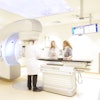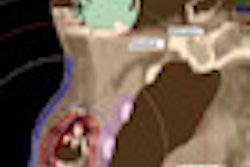Accelerated partial-breast irradiation (APBI) using breast brachytherapy offers women with early-stage breast cancer a rapid five-day course of radiation treatment. However, until recently, APBI treatment was not an option for most women with small breasts or a tumor located close to the chest wall and lung or the surface of the skin.
The introduction of multicatheter single-entry brachytherapy devices is beginning to change the situation. These applicators are introduced into the patient through a single incision in the breast, but once the catheter reaches the treatment site, the device can be expanded to conform to the size of the cavity and deliver radiation from multiple sources.
The applicators enable radiation oncologists to better target the radiation dose delivered to the shape and size of a tumor, avoiding healthy tissue in the chest wall, lung, and skin. This capability enables many patients whose tumors were within 7 mm of the chest wall or skin to successfully receive APBI treatment.
The advantage of a multicatheter brachytherapy device compared to a single-source device is that the former's catheters can be loaded with radiation sources at different strengths for dose modulation. While interstitial brachytherapy achieves the same result, it requires the insertion of multiple catheters, a technically complicated procedure requiring a high level of expertise.
The effectiveness of multicatheter applicators is highlighted in two studies that report excellent cosmesis and minimal skin toxicity. One study was published in the January 2009 issue of Radiotherapy and Oncology (Vol. 90, pp. 36-42), and the other was presented as a poster at the 2008 annual meeting of the American Society for Radiation Oncology (ASTRO).
These studies, by radiation oncologists at the University of California, San Diego Medical Center (UCSDMC) in La Jolla and 21st Century Oncology of Fort Myers, FL, describe the use and patient outcomes of the Strut-Adjusted Volume Implant (SAVI) applicator (Cianna Medical, Aliso Viejo, CA).
SAVI is one of two single-entry brachytherapy devices with multiple catheters that have U.S. Food and Drug Administration (FDA) clearance; the other is the Contura multilumen balloon catheter by SenoRx of Irvine, CA.
UCSD experiences
UCSD's department of radiation oncology began to use SAVI devices in April 2007 and was the second cancer center in the U.S. to do so. Research team leader Dr. Catheryn Yashar, chief of breast and gynecological radiation services, and fellow radiation oncology colleagues describe their clinical implementation experiences and outcomes of the first 20 patients who received SAVI APBI in the article in Radiotherapy and Oncology.
Patients eligible for a SAVI implant have a pathologically proven diagnosis of noninvasive or T1/T2 breast tumors 3 cm or less in size, with negative margins, negative axillary nodes, and no distant metastases. In addition, breast-conservation surgery must have been performed within a less than six-week time period. A CT scan is performed seven days prior to the implant date to evaluate the postoperative tumor bed and to determine the size, symmetry, and long axis of the lumpectomy cavity.
The SAVI catheter is inserted with the device in a collapsed position. When a knob at the end of the device is turned, the peripheral struts expand into the surrounding tissue, pushing against the cavity walls. Outward pressure from the expanded struts secures them in place. A CT scan is performed to verify the proper deployment of the struts and for treatment planning.
Multiplanar reconstruction within the planning system (Plato, Nucletron, Veenendaal, Netherlands) makes reconstructing the catheters straightforward, regardless of their anatomical location, according to the authors.
After images are imported into the treatment planning software and the physician draws the lumpectomy cavity, the cavity volume is expanded by 1 cm. The planning target volume is the difference between the expanded volume and the cavity volume, conformed to the patient's anatomy and contoured to stay 5 mm from the skin and outside of the pectoralis muscle. Replanning is not necessary prior to each fraction unless air gaps appear between the struts and tissue or if the device has splayed struts.
Use of a breast board is the most successful way to ensure reproducible patient positioning, and it is necessary to ensure that treatments coincide with the treatment plan, according to the article's lead author, Dan Scanderbeg, Ph.D. Patients receive 10 fractions of 340 cGy per fraction twice daily for five days, with treatments separated by six hours. The skin dose is kept below 100% of the prescribed dose and the maximum lung dose does not exceed 75% of the prescribed dose.
Patients have CT scout views of anterior and lateral x-ray images that are compared to the original postoperative images. The authors report that 25% of the patients' first scout film showed a significant difference between the original one acquired for treatment planning, and none thereafter. Out of a total of 200 fractions, there was interfractional movement in five fractions.
Based on the experience of UCSD radiation oncologists, the early stages of the SAVI implant are the most sensitive to motion in the first 24 hours after placement. Motion is caused by air gaps and struts asymmetrically splayed on the anterior side of the device. In four out of five instances, the problems corrected themselves within 24 hours. Because of this, the authors recommend that for these patients, treatment be postponed until the patient has a CT scan 24 hours later, and treatment planning is recalculated from the new images.
Eight, or 40%, of the 20 patients in the UCSD study would not have been eligible for other types of ABPI treatments due to skin spacing restrictions. The authors did not report if any of the patients in their cohort had tumors near the chest wall. However, this percentage of women who would not have been eligible for other types of APBI is similar to that reported by radiation oncologists at Arizona Oncology Services of Phoenix, the first cancer treatment center in the U.S. to use the SAVI device. Of the site's first 102 patients receiving a SAVI implant, 34 had lumpectomy cavities less than 7 mm from the chest wall, and 23 were treated with a skin-cavity spacing of less than 7 mm.
Skin toxicity outcomes
In the ASTRO poster presentation, radiation oncologists from 21st Century Oncology reported on the skin toxicity outcomes of 12 of 42 patients participating in a phase II trial. These patients had less than 7 mm skin-to-cavity spacing.
All 42 patients had similar eligibility requirements as in the UCSD study, and treatment planning parameters were similar. These patients also received a total dose of 34.0 Gy administered in twice-daily fractions for five consecutive days. The dosimetric parameters are shown below:
|
All patients were followed for six months. Principal investigator Dr. Constantine Mantz reported that erythema, desquamation, edema, seroma, and infection were assessed during treatment and after treatment completion at 14 days, 30 days, 90 days, and 180 days. Patients were classified with three levels of toxicity: none, seen on close observation (grade 1), and obvious on casual observation (grade 2).
Of this subset of 12 patients, nine developed grade 1 and 2 radiation erythema by 14 days following treatment. This toxicity disappeared in the nine patients within 90 days. Eight of the 12 patients developed grade 1 and 2 edema by 14 days following treatment. This toxicity disappeared for all but two patients who continued to have grade 1 edema.
None of these patients had dry or moist desquamation at any follow-up point, or had seroma, pigmentation change, fibrosis, or infection. Eleven of the patients had excellent cosmesis at 90 days. One patient had fair cosmesis, attributed to asymmetry due to volume loss secondary to surgery.
The phase II clinical trial being conducted by 21st Century Oncology began in July 2007. Its objective is to measure acute toxicity, chronic toxicity, and local disease control of 250 women receiving SAVI treatment and is still open to enrollment, Mantz told AuntMinnie.com. As of January 2009, an additional 38 women have been treated with no major adverse effects.
For early stage breast cancer patients who desire the most rapid radiation therapy treatment timeline possible, these reports of the earliest adopters of APBI using single-entry multicatheter devices are promising.
By Cynthia E. Keen
AuntMinnie.com staff writer
April 3, 2009
Related Reading
Two-day APBI breast cancer treatment reported safe and effective, December 2, 2008
Brachytherapy preserves cosmesis in breast cancer patients with implants, December 1, 2008
Study: APBI compares favorably to standard RT, October 1, 2008
Copyright © 2009 AuntMinnie.com



















